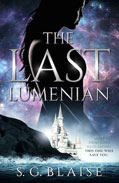
 |
Blaise's debut novel is bursting with deeply thought-out worldbuilding, tension, and a wide cast of characters with a blend of science fiction and fantasy. The plot follows Lilla, the ma'hana (princess) of Uhna, the wealthiest planet in the Pax Septum Coalition. Though a princess, Lilla has little to no say in how to lead her life. She is expected to be seen but not heard, and her duties are to marry whomever her father sees fit. However, Lilla is not someone to take lightly. She's stubborn, outspoken, and a rightfully deserved headache to her father. Where Uhna's outdated customs don't allow women to be involved in politics, Lilla finds no other way to push back except to join the rebel forces, even if she must go against her father, the king, in doing so.
Yet, there is so much more at stake in this novel. Refugee retaliation resulting from mistreatment is one conflict that much of the plot revolves around. However, Lilla finds herself in a much larger-scaled battle when she discovers she is the last Lumenian, a descendant of the Archgoddess of the Eternal Light and Order. As the last of her bloodline, Lilla is forced into an Era War between gods that will determine the fate of not just Uhna but all the Seven Galaxies.
Along the way, there is a long list of characters among the rebels, royals, and Teryns visiting Uhna for alliance negotiations. Some characters are hard to keep track of, but several stand out and are adequately developed alongside the protagonist. It is especially nice to see how down-to-earth Lilla is with some of these individuals despite being a princess. For example, two of the servants at the palace—a healer and a cook—are her closest friends. On the other hand, some characters, such as her brother, are not as developed despite having several appearances.
This book is definitely a page-turner with its short chapters and fluid writing style. Lilla's character, though, is a study in contrasts. For example, her refusal to help the Archgoddess on more than one occasion, seeming to care very little for what might happen if an Era War really does play out, comes across as a bit jarring. Yet, she also has a sense of justice, risking her own station in life to help refugees her father sees as nothing more than forced laborers.
Blaise's inclusion and portrayal of anxiety disorder in the form of claustrophobia is well done. So often in this genre, protagonists are fearless and strong, able to overcome anything. Instead, Blaise takes a realistic approach in her characterization, showing that weakness and strength aren't exclusive to one another. Lilla is strong-willed but struggles with her fear of enclosed spaces, which causes several incidents where she feels helpless. Having someone with an anxiety disorder in a sci-fi fantasy is a much-needed addition to the genre and makes Blaise's story unique. Not only does this inclusion stand out, but so too does the magic system, which goes a step further from elemental magic. Seeing how magic contributes to advanced technology throughout the worldbuilding ties the sci-fi and fantasy genres together nicely. Overall, Blaise's debut is impressive and worth the read.
A 2021 Eric Hoffer Book Award da Vinci Eye Finalist
Next Focus Review
Previous Focus Review